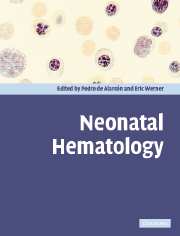Book contents
- Frontmatter
- Contents
- List of contributors
- Foreword
- Preface
- 1 Neonatal hematology: a historical overview
- 2 Disorders of the fetomaternal unit
- 3 Erythropoiesis, red cells, and the approach to anemia
- 4 Anemia of prematurity and indications for erythropoietin therapy
- 5 Hypoplastic anemia
- 6 Hemolytic disease of the fetus and newborn
- 7 Neonatal hemolysis
- 8 Neonatal screening for hemoglobinopathies
- 9 Polycythemia and hyperviscosity in the newborn
- 10 Newborn platelet disorders
- 11 Neutrophil function and disorders of neutrophils in the newborn
- 12 Immunodeficiency diseases of the neonate
- 13 Hemostatic abnormalities
- 14 Transfusion practices
- 15 Umbilical-cord stem-cell transplantation
- 16 Neonatal oncology
- 17 Normal values and laboratory methods
- Index
- References
4 - Anemia of prematurity and indications for erythropoietin therapy
Published online by Cambridge University Press: 10 August 2009
- Frontmatter
- Contents
- List of contributors
- Foreword
- Preface
- 1 Neonatal hematology: a historical overview
- 2 Disorders of the fetomaternal unit
- 3 Erythropoiesis, red cells, and the approach to anemia
- 4 Anemia of prematurity and indications for erythropoietin therapy
- 5 Hypoplastic anemia
- 6 Hemolytic disease of the fetus and newborn
- 7 Neonatal hemolysis
- 8 Neonatal screening for hemoglobinopathies
- 9 Polycythemia and hyperviscosity in the newborn
- 10 Newborn platelet disorders
- 11 Neutrophil function and disorders of neutrophils in the newborn
- 12 Immunodeficiency diseases of the neonate
- 13 Hemostatic abnormalities
- 14 Transfusion practices
- 15 Umbilical-cord stem-cell transplantation
- 16 Neonatal oncology
- 17 Normal values and laboratory methods
- Index
- References
Summary
Introduction
Anemia of prematurity is a multifactorial anemia characterized by relatively low plasma erythropoietin (EPO) levels, iatrogenic blood loss, low circulating blood volumes, and insufficient erythropoiesis. This anemia has been long characterized as nutritionally insensitive, but nutrition may influence its clinical course. Anemia of prematurity is treated with erythrocyte transfusions, and many published studies have examined the potential of recombinant human erythropoietin (rhEPO) therapy. Although rhEPO therapy is associated with a statistically lower number of transfusions, it does not eliminate transfusions in most premature infants. In addition, optimal dosage, route of administration, and timing of rhEPO therapy in prematurity remain under study. Of concern, rhEPO therapy is associated with both functional iron deficiency and depleted iron stores in other populations. In prematurity, rhEPO is given in conjunction with supplemental iron, but long-term iron status of premature infants after rhEPO therapy has been studied poorly.
Physiology of anemia of prematurity
EPO, the primary hormone regulating erythropoiesis, is measurable throughout fetal gestation [1]. In the fetus and newborn, EPO is produced primarily by the liver, which may be relatively insensitive to hypoxia compared with the kidney [1, 2]. After term birth, erythropoiesis is suppressed by markedly improved postnatal oxygen delivery and a relatively depressed plasma EPO level; consequently, a fall in hemoglobin occurs, which reaches physiologic nadir in the first months postpartum [3]. This response is exaggerated in premature infants [4].
- Type
- Chapter
- Information
- Neonatal Hematology , pp. 58 - 67Publisher: Cambridge University PressPrint publication year: 2005
References
- 1
- Cited by



